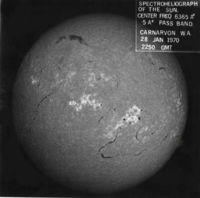The Sun Explained
Back to Station Equipment
David Johns, one of Carnarvon's SPAN scientific observers, describes the Sun and explains the purpose of the SPAN observatory:
"The inner Sun is a giant thermo-nuclear furnace. Rising heat keeps the solar surface at about 6,000°C but localised hot spots can develop that may suddenly flare and spit off X-rays and electron and proton radiation. The particle radiation sprays out through the solar system and is known as the solar wind.
Some of the solar wind that passes near the earth becomes trapped in the earth's magnetic fields and is absorbed into the upper atmosphere causing radio propagation disturbances, magnetic storms and visible polar auroras.
Almost none of the non-visible radiation penetrates down to ground level so humans are protected from its harmful effects.
However, there is no effective protection from particle radiation if a large flare occurs while a human is outside of the earth's atmosphere and magnetic field and on the way to the moon, or worse still, walking on the surface of the moon.
NASA did not have long term data on the intensity or frequency of solar flares and solar radiation so it built three solar observatories around the world to develop a continuous data base of the frequency and intensity of solar flares and, if possible, learn the precursors so that large solar flares could be predicted."

